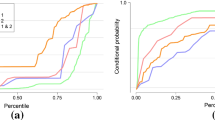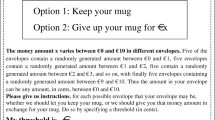Abstract
The experimental as well as the non-market valuation literature include several examples of how an introduced price can affect behavior in otherwise not expected ways. It has become standard to include a price vector as an attribute in choice experiments, something that enables us to estimate a marginal willingness to pay for other attributes. We test the impact on preferences by an inclusion of a price in a choice experiment. Preferences are affected, as might be expected. However, also the relative ranking of individual attributes is affected.
Similar content being viewed by others
References
Alpizar F, Carlsson F, Martinsson P (2003) Using choice experiments for non-market valuation. Econ Issues 8:83–110
Andreoni J (1989) Giving with impure altruism: applications to charity and Ricardian equivalence. J Polit Econ 97:1447–1458
Ariely D, Loewenstein G, Prelec D (2003) Coherent arbitrariness: stable demand curves without stable preferences. Q J Econ 118:73–105
Braga J, Starmer C (2005) Preference anomalies, preference elicitation and the discovered preference hypothesis. Environ Resour Econ 32:55–89
Bryan S, Parry D (2002) Structural reliability of conjoint measurement in health care: an empirical investigation. Appl Econ 34:561–567
Bunch D, Louviere J, Andersson D (1996) A comparison of experimental design strategies for choice-based conjoint analysis with generic-attribute multinomial logit models. Working Paper, Graduate School of Management, University of California, Davis
Frey BS (1997) Not just for the money. an economic theory of personal motivation. Edward Elgar, Cheltenham
Frykblom P, Shogren J (2000) An experimental testing of anchoring effects in discrete choice questions. Environ Resour Econ 16:329–341
Green D, Jacowitz KE, Kahnemann D, McFadden D (1998) Referendum contingent valuation, anchoring, and willingness to pay for public goods. Resour Energy Econ 20:85–116
Hensher D (2006) Revealing differences in willingness to pay due to the dimensionality of stated choice designs: an initial assessment. Environ Resour Econ 34:7–44
Krinsky I, Robb A (1986) On approximating the statistical properties of elasticities. Rev Econ Stat 68:715–719
List J, Berrens R, Bohara A, Kerkvliet J (2004) Examining the role of social isolation on stated preferences. Am Econ Rev 94:741–752
Louviere J, Hensher D, Swait J (2000) Stated choice methods. Cambridge University Press, Cambridge
Malhotra N (1982) Structural reliability and stability of nonmetric conjoint analysis. J Mark Res 19:199–207
McCullough J, Best R (1979) Conjoint measurement: temporal stability and structural reliability. J Mark Res 16:26–31
Plott C (1996) Rational individual behavior in markets and social choice processes. The discovered Preference Hypothesis. In: Arrow K, Colombatto E, Perleman M, Schmidt C (eds), Rational foundations of economic behavior. Macmillan and St. Martin’s, London, pp. 225–250
Poe G, Giraud K, Loomis J (2005) Computational methods for measuring the difference of empirical distributions. Am J Agric Econ 87:353–365
Reibstein D, Bateson J, Boulding W (1988) Conjoint analysis reliability: empirical findings. Mark Sci 7:271–286
Siegel S, Castellan NJ (1988) Nonparametric statistics for the behavioral sciences. McGraw-Hill International Editions
Sugden R (2005) Coping with preference anomalies in cost-benefit analysis: a market simulation approach. Environ Resour Econ 32:129–160
Swait J, Louviere J (1993) The role of the scale parameter in the estimation and comparison of multinomial logit models. J Mark Res 30:305–314
Train K (2003) Discrete choice methods with simulation. Cambridge University Press, New York
Tversky A (1996) Rational theory and constructive choice. In: Arrow KJ, et al. (eds) The rational foundations of economic behavior: Proceedings of the IEA Conference held in Turin, Italy. IEA Conference vol, no. 114. New York: St. Martin’s Press; London: Macmillan Press in association with the International Economic Association: 185–197
Wiley JB (1978) Selecting Pareto optimal subsets from multiattribute alternatives. Adv Consum Res 5:171–174
Author information
Authors and Affiliations
Corresponding author
Rights and permissions
About this article
Cite this article
Carlsson, F., Frykblom, P. & Lagerkvist, C.J. Preferences with and without prices - does the price attribute affect behavior in stated preference surveys?. Environ Resource Econ 38, 155–164 (2007). https://doi.org/10.1007/s10640-006-9068-1
Received:
Accepted:
Published:
Issue Date:
DOI: https://doi.org/10.1007/s10640-006-9068-1




